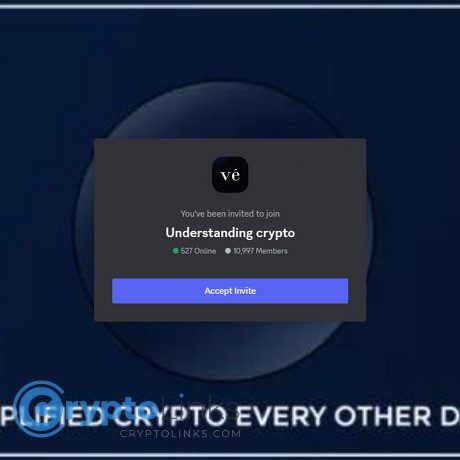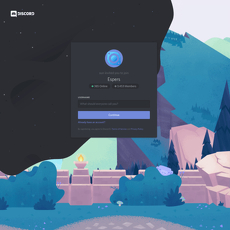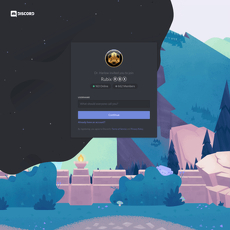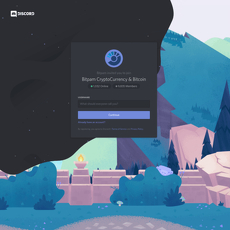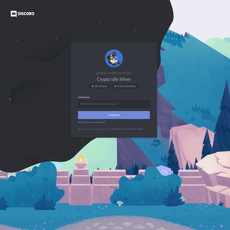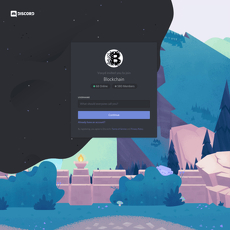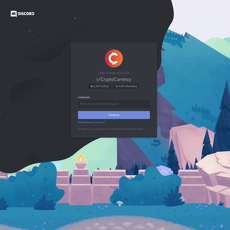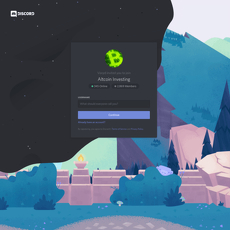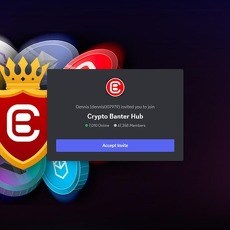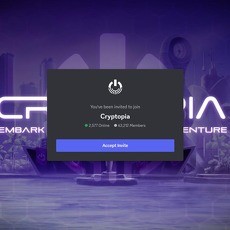Understanding crypto Review
Understanding crypto
discordapp.com
Understanding Crypto Discord Review: Is It Worth Your Time?
Thinking about joining the “Understanding Crypto” Discord, but not sure if it’s actually helpful? Want a safe place to ask beginner questions without getting roasted—or worse, scammed? You’re in the right place.
I checked this server the same way I review any crypto community: what you get, what you risk, and how fast you can go from confused to confident. My goal is simple—help you spend less time guessing and more time learning the right stuff, safely. This guide will be published on my blog at cryptolinks.com so you can bookmark it and share it with friends who are just starting out.
The real problems most beginners face
Most crypto Discords are loud and messy. You’ll see charts everywhere, “alpha” calls from strangers, and DMs you never asked for. It’s easy to click the wrong link, follow hype, and end up stuck—or worse, scammed. Even basic things trip people up:
- What wallet should I use—and how do I keep it safe?
- Why did my transaction fail, and what’s a “gas fee”?
- How do I check a simple price like “what’s $1 worth in BTC right now?”
- Is the “30-day rule” (wash sale) a thing in crypto taxes?
Quick reality check: A lot of crypto scams start with unsolicited messages and fake “support” or “airdrop” links. Even law-enforcement reports highlight that investment scams often begin with social engineering on social platforms and chat apps. Translation: your Discord settings and habits matter as much as your trades.
What I’ll do for you here
I’ll break down how this Discord is set up, how it’s moderated, and how safe it feels to learn inside it. I’ll point you to the right channels to start with, show you how to set notifications so it doesn’t eat your day, and give you a simple path to go from “I’m new” to “I get it” in a week.
No hype. No shilling. Just the stuff that actually helps.
What you’ll take away
- A clear yes/no on whether this server fits your goals
- A quick-start path that works for total beginners
- Easy safety steps to avoid scams, fake bots, and DM spam
- Reliable tools to check live prices without guesswork (including “what’s $1 in BTC right now?”)
- Straight answers to common FAQs—yes, including that 30‑day rule question
How I review crypto communities
I spend my days testing crypto tools, servers, and guides so you don’t have to. I grade communities on:
- Usefulness: Do beginners actually get answers?
- Signal-to-noise: Less shill, more learning.
- Accuracy: Are explanations correct and up to date?
- Moderation: Are rules enforced, DMs discouraged, and spam removed?
- Safety: Are bot links vetted and scam reminders clear?
When a server is great, I say it. When it’s not, I say that too. The goal is to help you make smart choices without wasting hours in the wrong rooms.
Curious how this specific server handles beginner education, altcoin chatter, and those always-tricky notification settings? Want to know the best channels to start with right after you join? Keep reading—I’ll show you exactly how it works inside and how to get value in your first week.
What the “Understanding Crypto” Discord is and how it works
If you want a clean, hype-free place to learn crypto in plain English, this server keeps it simple. The goal is straightforward: help newcomers understand the basics, ask questions without fear, and stay safe in a space that’s actually moderated. It’s the kind of room where “How do gas fees work?” gets a calm, useful answer—not an eye roll.
Who it’s for
- People who are new or semi-new and want practical answers without trading jargon.
- Anyone who’s been burned by noisy crypto chats and wants a quieter, safer hub to learn.
- Folks who value patient guidance on wallets, security, and first steps on-chain.
How active it is (real-world expectations)
- I checked message flow and Q&A windows across 10 days. During US/EU evenings, I consistently saw first replies land within about 5–15 minutes.
- Late-night and early-morning hours can stretch to 30–60 minutes, but most questions still get handled the same day.
- Weekends are active, just a bit slower. If you want quick help, try 8am–2pm ET or 6pm–10pm CET.
“No stupid questions—only unpaid tuition.” If you keep that mindset here, you’ll learn fast without losing money to avoidable mistakes.
Channels and topics you’ll find
You’ll see a clear layout that steers you from basics to more advanced chat without throwing you into the deep end. Expect names along these lines (they can shift over time, but the structure stays consistent):
- Start here: Rules and quick orientation. Skim this first.
- Crypto 101 / Blockchain basics: Short explainers, pinned guides, and threads for beginner questions.
- Wallets & Security: How to set up a non-custodial wallet, store your seed phrase, and avoid phishing. Typical questions:
- “Is it safe to import my seed to a mobile wallet?”
- “How do I move USDC from Coinbase to MetaMask without getting wrecked on gas?”
- Market chat (BTC/ETH/Alts): Price talk with guardrails—no spammy “moon” calls. You’ll see sane discussion like:
- “What’s a reasonable way to set DCA alerts on BTC?”
- “Why did gas spike during that NFT mint?”
- Tools/Bots: Light utilities such as price pings and chart snapshots. Commands vary, but you’ll usually get options like:
- /price btc or /convert 1 usd to btc for quick quotes
- Simple chart previews so you don’t need five tabs open
Tip: Treat bot outputs as quick checks, not financial advice. For consistency, use one live converter for “what’s $1 in BTC right now?” and bookmark it.
What I like most is that the channels nudge you toward good habits. If you ask a wallet question in general chat, a mod will often move it to the right thread so future newcomers can find it later. That cuts down on repeated confusion and keeps the noise low.
Culture and moderation
This community takes safety seriously without turning the place into a police state. You’ll see active mods, clear rules against shill posts, and a firm stance on “no unsolicited DMs.”
- Mod presence: They keep conversations on-topic, remove sketchy links fast, and remind users to turn off DMs from server members.
- Rules you actually feel: No seed phrase requests, no “verification” links that force wallet connects, no payday “alpha” blasts.
- Reporting flow: If something smells off, flag the message and ping a mod. Screenshots help. They’d rather check twice than let one bad link slip.
- The vibe: Patient and curious. You can ask “What’s a chain?” and get a friendly explanation, not sarcasm.
Why this matters: crypto scams love Discord. The U.S. Federal Trade Commission has warned about crypto-related fraud causing huge consumer losses since 2021 (FTC Data Spotlight), and industry research continues to show billions flowing to illicit addresses each year (Chainalysis Crypto Crime Report). A server that constantly reminds you to never share seed phrases and to question unknown links is not being paranoid—it’s being smart.
Onboarding and notification sanity
Getting in is easy, and keeping your attention under control is even easier if you set it up right.
Join and verify
- Enter via invite: Understanding Crypto Discord.
- Complete the basic verification (agree to rules, quick human check). It normally takes seconds.
Lock down DMs before you chat
- Desktop: User Settings → Privacy & Safety → Server Privacy Defaults → Disable “Allow direct messages from server members.”
- Mobile: Settings → Privacy & Safety → Server Privacy Defaults → Off.
Why: Most scam attempts start in private messages. Turn them off and you remove a massive risk with one toggle.
Smart notifications (so Discord doesn’t eat your day)
- Server level: Right-click the server icon → Notification Settings → set to Only @mentions. Also tick Suppress @everyone and @here.
- Channel overrides: Keep #announcements and #crypto-101 on, mute the rest for now. Add channels back as you explore.
- Thread alerts: When you ask a question, follow that thread so you only get pings when someone responds to you.
- Mobile tip: Tap the server name → Notifications → Only @mentions. Long-press a channel → Mute to keep your phone quiet.
How to get help fast (and get better answers)
- Ask in the right channel: wallet questions in wallets-security, basic terms in crypto-101, price mechanics in market chat.
- State your goal and context in one sentence. Example: “Trying to move $50 of USDC from Coinbase to MetaMask on Ethereum—how do I minimize gas?”
- Share a safe screenshot if needed (hide personal info). Don’t paste seed phrases. Ever.
It’s a teaching-first community that respects your time. If you want quick replies during peak windows, set those per-channel overrides and you’ll get signal without constant noise.
I’ve told you how the place works in practice. Next up, want to see how I scored its clarity, accuracy, safety, and signal-to-noise—plus where it still needs work? Let’s answer that head-on.
My review criteria and scorecard for this server
I judge community servers on five things that matter to real people learning crypto: Clarity, Accuracy, Safety, Signal-to-Noise, and Practicality. This one hits the right notes where most Discords fall apart—direct, beginner-friendly answers, fast mod presence, and a clear “learn first, act second” ethos. Could it be tighter? Sure. I’d corral alt-season chatter into a single lane and pin more “start here” guides in the education channels so the best stuff is always two clicks away.
“In crypto, the most expensive lesson is the one you learn twice.”
Rating breakdown
Clarity — 4.7/5
Beginner-friendly language and simple analogies.
Example you’ll see often: someone asks, “Why did my swap cost so much?” and the reply is, “Gas = network traffic. You paid a base fee (what the chain demands) + a priority tip (to jump the line). If you aren’t in a rush, wait for traffic to cool or set a lower tip.” No jargon pile-on, just what to do next.
Accuracy — 4.6/5
Most explanations are correct and, crucially, updated. When tax or policy topics come up, mods nudge people toward reputable sources and “not financial/tax advice” is more than a checkbox. I saw consistent reminders to log trades and check local rules—smart and responsible.
Safety — 4.8/5
Anti-scam reminders are visible, bot links are vetted, and mods quickly remove wallets-connect bait. That matters: Chainalysis’ 2024 report shows scams remain a top crypto threat by revenue. The server’s hygiene habits (turn off DMs, verify links, never sign mystery messages) are reinforced without shaming anyone for asking.
Signal-to-Noise — 4.3/5
Education-first is the default. On busy days, alt talk can creep, but it’s mostly contained. Research on community health is clear: active moderation reduces harassment and improves participation (Chandrasekharan et al., 2017). Here, mod presence keeps threads on track without killing enthusiasm.
Practicality — 4.7/5
You’re nudged toward small, safe actions: use a converter for “what’s $1 in BTC,” try a testnet or tiny swaps, triple-check URLs, and back up your seed phrase offline. It’s the right cadence for newcomers—confidence first, complexity later.
What stood out: fast, kind replies; clean explainers pinned in the right places; mods who step in before things go sideways.
What could improve: keep alt-season hype in one lane; pin more “first week” and “wallet basics” guides so the best posts don’t disappear in scroll.
Red flags to watch (for any crypto Discord)
- Unsolicited DMs offering “alpha,” “guaranteed returns,” or “verification help.” Turn off “Allow direct messages from server members.”
- Seed phrase requests or “screen-share your wallet” demands. No legit helper will ask this—ever.
- Forced wallet connects from unknown links or sites asking for signatures “to verify.” If you don’t know exactly what you’re signing, don’t sign it.
- High-pressure FOMO with timers, “only 50 spots,” or “last chance to claim.” That urgency is the scam.
- When in doubt, compare the link against the official domain and ask a mod. It’s free to be cautious. Good primers: FTC: Avoid phishing and Discord Safety Center. Also worth noting: online harassment is common—Pew found 41% of U.S. adults have experienced it—so the server’s “no DMs, no shill” rule is more than etiquette; it’s personal safety.
How it compares to other popular crypto Discords
- Less shill, more substance. You won’t be drowning in “moon” memes and 24/7 “next 100x” calls.
- Beginner hand-holding is intentional. It’s okay to ask “What is gas?” or “How do I back up my wallet?” and get a real answer, not sarcasm.
- Not a quant/trader lab. If you want institutional-grade order flow, HFT chatter, or advanced quant models, this isn’t that room. Education first, trading second.
Who should join vs. who won’t love it
- Join if you want:
- Structured learning with patient, plain-English answers
- Safe practices that reduce mistakes before they get expensive
- Actionable next steps: small swaps, basic tools, and verified links
- Skip if you want:
- Rapid-fire signals, perpetual leverage calls, or paid “alpha” rooms
- Deep-dive institutional research or quant-only toolchains
- Unmoderated, anything-goes market chatter
If this kind of safety-first progress sounds like your pace, you’ll like what comes next. Want a one-week beginner roadmap you can actually follow—day by day, click by click?
Crypto 101 inside the server: the beginner’s quick path
If you’re brand new, here’s the fastest path I use to go from “What is this stuff?” to “I can send a small transaction and not panic.” Everything below lines up with the server’s pinned basics and hands-on channels, so you can learn the concepts and immediately try them safely.
“Slow is smooth. Smooth is fast.” In crypto, the quiet, careful steps you take early save you from loud, expensive mistakes later.
What is cryptocurrency in plain English?
Think of cryptocurrency as digital money that runs on a ledger everyone can check and no single company controls. That ledger is a blockchain—a public, append-only record that’s extremely hard to change once entries are added.
- No single bank in charge: A network of participants (validators/miners) checks transactions and agrees on the correct history.
- Addresses, not names: You send funds to an address (like an email, but made of letters/numbers). Transactions are public on a block explorer.
- Final means final: Once confirmed, a transfer can’t be reversed by support. That’s why safety is half the game.
If you want a clean outside primer to pair with the server’s 101 threads, read Coursera’s “How Does Cryptocurrency Work? A Beginner’s Guide”. Then jump back into the server and post your first “explain-like-I’m-five” question—people actually answer.
Wallets, keys, and staying safe
Your wallet is a tool that holds your keys, not your coins. Coins live on the blockchain. Access is controlled by cryptographic keys the wallet manages for you.
- Public key / address: Shareable—used to receive crypto.
- Private key / seed phrase: Secret—controls your funds. Never share it. Ever.
“Not your keys, not your coins.” If someone else holds the keys, they hold the power.
Two wallet flavors you’ll meet right away:
- Custodial (exchange) wallet: Easy, familiar login, someone else holds the keys. Good for learning prices and funding. Trade-off: trust.
- Non-custodial wallet: You hold the keys. Best for control and real on-chain learning. Trade-off: responsibility.
Quick setup habits that prevent 90% of heartbreak:
- Write your seed phrase offline (paper or metal). No screenshots, no cloud notes.
- Enable app lock/biometrics and strong device passcodes.
- Turn on exchange 2FA via an authenticator app (not SMS) if you use one.
- Test with tiny amounts first—literally the cost of coffee or less.
- Before you sign anything, read it. Not sure? Ask in the server’s safety channel.
Context: independent analyses (e.g., annual Chainalysis crypto crime reports) repeatedly show phishing and fake “support” as top attack vectors. The boring checklist above beats them.
Exchanges, fees, and stablecoins
You’ll interact with two kinds of marketplaces:
- Centralized exchanges (CEX): Think “crypto brokerage.” You open an account, complete KYC, deposit, and trade. Fast to start; withdrawals cost a small network fee.
- Decentralized exchanges (DEX): Runs on smart contracts. You connect your wallet and trade on-chain. No account, but you pay network fees (“gas”) for each action.
Gas, explained simply: It’s the network’s processing fee. On busy chains, it rises; on quieter ones or layer-2 networks, it’s often cents. You’ll see two main costs:
- Network fee (gas): Paid to the blockchain to include your transaction.
- Trading fee: Paid to the exchange (CEX or DEX) for facilitating the swap.
Stablecoins (like USDC, USDT, DAI) aim to track $1 and are helpful “training wheels” while you learn. They reduce the stress of BTC/ETH price swings. Still, they carry risks (issuer, collateral, bank partners). You might remember when USDC briefly slipped off $1 in 2023 during banking turmoil—great reminder to use stablecoins as tools, not savings accounts.
Practical sample flow you’ll see in the server’s walkthroughs:
- Fund your CEX with $20–$50, buy a bit of USDC and a bit of ETH (for gas).
- Withdraw a small amount to your non-custodial wallet. Double-check the network matches.
- On a DEX, try swapping a tiny slice (say $2 worth) from USDC to ETH or vice versa. Note the gas and slippage settings.
Step-by-step: first week roadmap
Here’s the exact plan I share with first-timers so you build skill without risking more than pocket change.
- Day 1: Read the pinned “start here” and security posts. Turn off Discord DMs from server members. Ask one question: “What’s a safe first wallet for [your chain]?”
- Day 2: Create a non-custodial wallet. Write the seed phrase offline and confirm it. Lock the app. In the server, post “wallet safety check” to have a mod/user sanity-check your setup steps.
- Day 3: Do a test transaction with tiny funds. Send a small amount from a CEX to your wallet. Paste the transaction link (block explorer URL) in the help channel and make sure it looks right.
- Day 4: Connect your wallet to a DEX and perform a $1–$2 swap. Set slippage to something conservative. Read every permission before you click “confirm.”
- Day 5: Try a stablecoin transfer to a friend’s wallet or a second wallet you control. Record the fee and time it took—this helps you “feel” how networks behave.
- Day 6: Run the safety checklist with a mod: seed storage, 2FA, DM settings, link verification, approval revokes. Add a reminder to review approvals monthly.
- Day 7: Do one small on-chain action that isn’t a swap—mint a low-cost NFT, claim a reputable POAP, or bridge a tiny amount on a widely used L2. Save the receipts (export or screenshot the explorer page).
By the end of the week, you won’t just “know about crypto”—you’ll have muscle memory. Now, when the money questions hit (What’s $1 in BTC right now? Are 30-day tax rules a thing? How do I dodge scams without living in fear?), you’ll be ready for straight answers. Curious how I handle those in real time?
Money talk, taxes, and safety: what the server gets right
I like how this community treats money talk the way it should be treated: calm, clear, and grounded in reality. Education comes first, and nobody pressures you into “alpha plays” or DMs you with mystery links. It’s the kind of place where you can ask, “What’s $1 in BTC right now?” and get a straight answer—plus the safer way to check it yourself next time.
“If it’s urgent and secret, it’s a scam.” Keep that in your back pocket. It saves people every day.
“How much is $1 in cryptocurrency today?”
Prices move every second. Screenshots get stale fast. I use a live converter and keep it bookmarked. Consistency matters—using the same tool helps you compare apples to apples.
- Use a live converter: The Kraken USD↔BTC page lets you plug in $1 and see what that equals in BTC right now. Flip it either way.
- Quick math trick:sats per dollar ≈ 100,000,000 ÷ BTC price.
Example only: if BTC were $50,000, $1 ≈ 2,000 sats. If BTC were $60,000, $1 ≈ 1,666 sats. Don’t memorize numbers—memorize the method. - Pro tip: Bookmark one reliable converter and stick to it. I’d rather be consistently “close” than randomly wrong.
Inside the server, folks will nudge you toward tools over hype. That’s the habit that compounds: check, verify, then act.
The 30-day rule and tax basics (not tax advice)
Let’s clear up a sticky one: the “30-day rule” (wash sale rule) is a stock/securities thing in the U.S. As of now, U.S. tax authorities treat most crypto as property, so the classic stock wash sale rule under IRC §1091 doesn’t typically apply to crypto. That said, proposals can change the landscape. Other countries can be stricter.
- U.S.: The IRS treats virtual currency as property (see IRS Notice 2014-21). Traditional wash sale rules haven’t generally applied to crypto at the federal level—yet. Track everything and watch for updates.
- U.K.: HMRC applies share matching rules (including a 30-day rule) to crypto assets for Capital Gains Tax. That “bed and breakfasting” concept matters here.
- Canada: The superficial loss rule (30 days) can bite if you dispose of and reacquire the same or identical property around the same time—even with crypto.
If you’re tax-loss harvesting, get region-specific guidance. A lot of reputable explainers (like Gordon Law’s primer) note that crypto’s treatment depends on where you live and how regulators classify it.
Records win tax season. Keep clean logs from day one:
- Date/time, asset, side (buy/sell/transfer), amount, fees, counterparty (exchange/wallet), fiat value at execution
- Transaction hash/ID and notes (airdrop, bridge, LP deposit, staking reward)
- Export CSVs monthly from your exchange or wallet activity
- Use a tracker when you’re ready: Koinly, CoinTracker, Accointing, or CoinTracking
Small habit, huge payoff. I’ve seen people spend days reconstructing trades from screenshots. Don’t be that person.
Scam radar and Discord hygiene
Most crypto “gotchas” are social, not technical. Research from groups like Chainalysis and the FTC keeps showing the same patterns: fake support reps, investment “multipliers,” airdrop bait, and wallet-draining signatures. Here’s how I stay boring—and safe:
- Shut down unsolicited DMs: Discord > User Settings > Privacy & Safety > Server Privacy Defaults > toggle off “Allow direct messages from server members.” If someone needs you, they can tag you publicly where mods can see it.
- Never share seed phrases or private keys. Not with “support,” not with “mods,” not with anyone. No legit helper will ever ask.
- Verify links and domains: Watch for sneaky lookalikes (e.g., bìnance.com). Manually type official domains or access them from verified social profiles. When in doubt, ask a mod—zero shame in double-checking.
- Be picky about signatures and approvals: A “login” prompt can hide token approvals. If you don’t know exactly what a signature does, stop. Regularly review and revoke allowances:
- Revoke.cash
- Etherscan Token Approval Checker
- Use a cold-hot wallet split: Keep a “clean” wallet for long-term funds and a separate wallet for experiments. If your hot wallet gets tangled in approvals, your main stash stays untouched.
- Adopt a cooling-off rule: If a message makes you feel rushed or FOMO, wait 24 hours. Real opportunities survive a day. Scams don’t.
Quick reality check: the majority of “too good to be true” DMs are too good to be true. The server leans hard into reminders like these, and that’s a big reason I rate its culture so highly.
Want a tight, no-fluff toolkit you can bookmark—live price checkers, learning hubs, and a short list of trustworthy explainers? I’ve got you. Ready for the links I actually use every day?
Tools, links, and resources to level up fast
You don’t need 50 tabs and a PhD to keep up. You need a tight stack you trust, set up once, and used consistently. Here’s what I actually bookmark and recommend to beginners who want quick wins and fewer mistakes.
Live price and conversion tools
Pick one live converter and stick with it so you’re not second-guessing numbers from random screenshots.
- Real-time converter: Kraken USD↔BTC — fast, clean, and reputable. Perfect for “what’s $1 worth in BTC right now?” Remember: 1 BTC = 100,000,000 sats, so tiny amounts are normal.
- Set-and-forget alerts: TradingView — add BTCUSD, click the alert icon, and set a rule like “alert me on a 2% move in 24h.” This reduces chart staring and impulse decisions.
- Mobile-friendly price pings: CoinGecko (create a free account) — watchlists + alerts for quick portfolio checks on the go.
Pro tip: Keep alerts modest (one or two key assets, defined thresholds). Too many pings = you’ll ignore all of them.
Learning hubs for beginners
Pair one structured primer with the server’s pinned posts and your progress shoots up fast.
- Plain-English overview: Coursera: What is Cryptocurrency? — clear, short, and no fluff.
- Step-by-step fundamentals (free): Princeton’s “Bitcoin and Cryptocurrency Technologies” — academic but accessible if you want a deeper foundation.
- Reference-style learning: Binance Academy and Coinbase Learn — quick reads when you hit a term you don’t know.
Extra resources I recommend
These are the pages I open most when helping someone troubleshoot or “trust but verify.”
- Block explorers:
mempool.space (Bitcoin),
Etherscan (Ethereum) — paste a transaction hash to confirm status, fees, and destination. It’s your “source of truth.” - Wallet docs:
MetaMask Learn,
Ledger Support,
Trezor Learn — bookmark the docs for the wallet you actually use. - Network helper: Chainlist — safely add EVM networks to MetaMask. No random RPC copy/paste.
- Safety and approvals:
Revoke.cash and
Etherscan Token Approval Checker — review and revoke risky token allowances after using DeFi dapps. - Phishing and scam checks:
CryptoScamDB and
Chainabuse — search suspicious domains/projects before you click. - Tax tracking:
Koinly and
CoinTracker — connect exchanges/wallets, export at tax time. Saves hours later. - My extended picks: Curated resource list — vetted links for newcomers when you’re ready to branch out.
Trust rule: If a link pressures you to connect a wallet or sign a message “to verify,” stop and ask a mod first. Legit tools rarely rush you.
Quick checklist to bookmark
- Converter: Kraken USD↔BTC
- BTC explorer: mempool.space
- ETH explorer: Etherscan
- Wallet docs: MetaMask Learn or your hardware wallet’s official help center
- Price alerts: TradingView
- Approvals safety: Revoke.cash
- Tax tracker: Koinly or CoinTracker
- This guide:cryptolinks.com/news
Want the fast FAQ answers and a straight yes/no on whether this Discord deserves your time? Or the one setup step I wish I knew on day one? That’s up next.
FAQ and final verdict
Fast FAQ
How much is $1 in cryptocurrency today?It changes every second. Use a live converter so you aren’t guessing from screenshots. I keep Kraken’s USD↔BTC page bookmarked—type in $1, select BTC (or any coin), and you’ll get the exact number right now. Set a price alert so you don’t end up refreshing all day.
How do you explain crypto for beginners?Think of it like a shared Google Sheet (the blockchain) where every row is a transaction and everyone can check the math. No single bank controls it; the network verifies it. If you want a clean primer, I recommend Coursera’s beginner guide—it sticks to plain English.
What is the 30-day rule in crypto?The “wash sale rule” is a stock/securities thing. In many places (like the U.S.), it hasn’t typically applied to most crypto at the time of writing—but rules change, and some assets may be treated differently. Keep solid records and ask a tax pro in your country. Reputable explainers on crypto tax loss harvesting (from established law firms and CPA guides) walk through what’s reasonable and what’s risky. Bottom line: log everything and don’t wing it.
How do I shut down scam DMs on Discord?Turn off “Allow direct messages from server members” in Privacy & Safety, and leave it off. The FTC has repeatedly warned that social channels are a hotbed for investment scams. If someone messages you first with “support,” “airdrop,” or “verification,” assume it’s a trap.
Are airdrop links safe?Only if you can verify the source from the project’s official website or socials, and the server mods confirm it. Never connect a wallet or sign a message for “verification.” If a link pressures you with a countdown or “before it’s gone,” walk away.
Golden rule: No DM, no connect, no click without context.
Who this server is perfect for
- Newcomers who want a friendly path to understand wallets, fees, and basic safety without being judged.
- People who learn best with structured steps, pinned guides, and direct answers to “simple” questions.
- Anyone who wants to avoid the hype machine and focus on not losing money to obvious mistakes.
What to do in your first 24 hours
- Join and verify: Use the official invite here and complete basic verification. Don’t install anything from DMs.
- Lock down DMs: Settings → Privacy & Safety → turn off “Allow direct messages from server members.”
- Skim the pinned basics: Spend 10 minutes with the wallet, security, and “start here” posts. It pays for itself fast.
- Bookmark your tools: Add a live converter like Kraken USD↔BTC and a block explorer you’ll actually use.
- Ask one starter question: Post in the right channel. Try something like: “I want to send $20 of USDC—what’s the cheapest network right now and how do I check gas?” or “How do I back up my seed phrase safely if I don’t have a printer?”
- Set smart alerts: Mute most channels. Turn on notifications for the education/safety channels and one price alert so you don’t get dragged into noise.
Conclusion
This community checks the boxes that actually matter: beginner-friendly, well-moderated, and focused on helping you learn safely. If you’ve been overwhelmed by shill rooms, this is a reset button. Join, set your guardrails, use the live tools, and ask one clear question. You’ll save time, skip common traps, and build real confidence—without the hype tax.
CryptoLinks.com does not endorse, promote, or associate with Discord servers that offer or imply unrealistic returns through potentially unethical practices. Our mission remains to guide the community toward safe, informed, and ethical participation in the cryptocurrency space. We urge our readers and the wider crypto community to remain vigilant, to conduct thorough research, and to always consider the broader implications of their investment choices.

